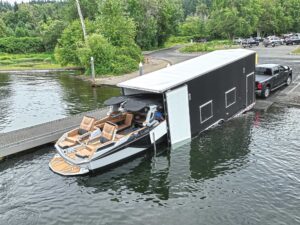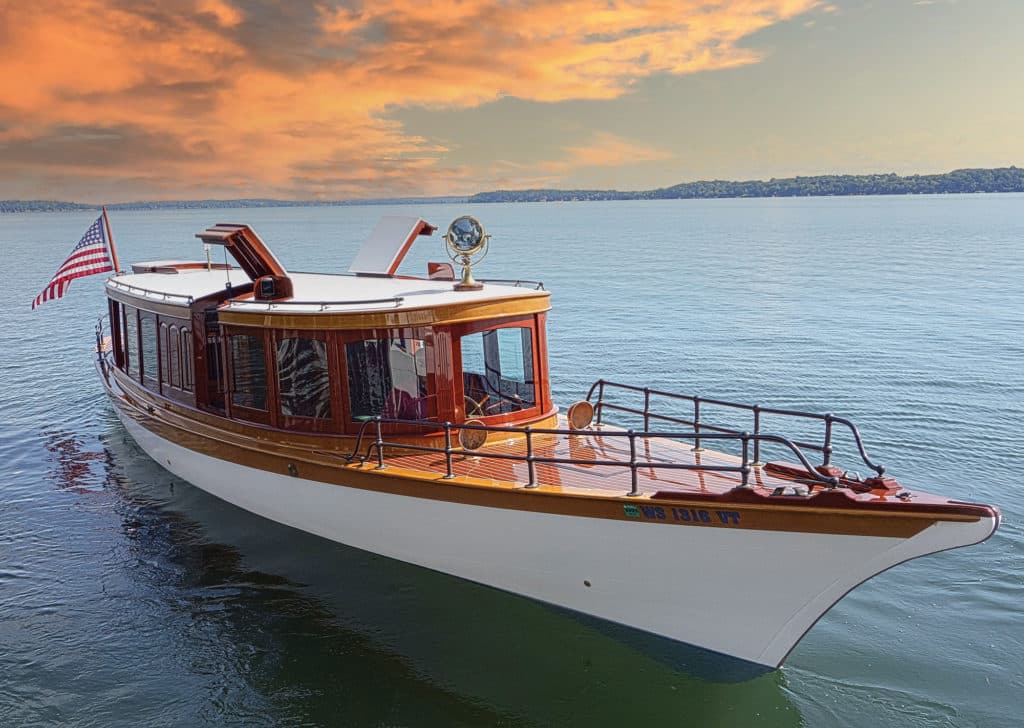
There’s something about owning an antique, classic boat. That is, until you have to repower it. Well, the options for repowering go beyond burning fossil fuels in today’s world. An old boat can become something entirely new when fitted with electric propulsion. Take the case of the antique launch On Point, which the owner recently repowered with an electric motor. The whole process provides some insight on the cost and logistics of replacing internal combustion with flowing electrons. The builder and owner shared all the details, and even let us take the wheel to experience the results firsthand. Here’s what we found.
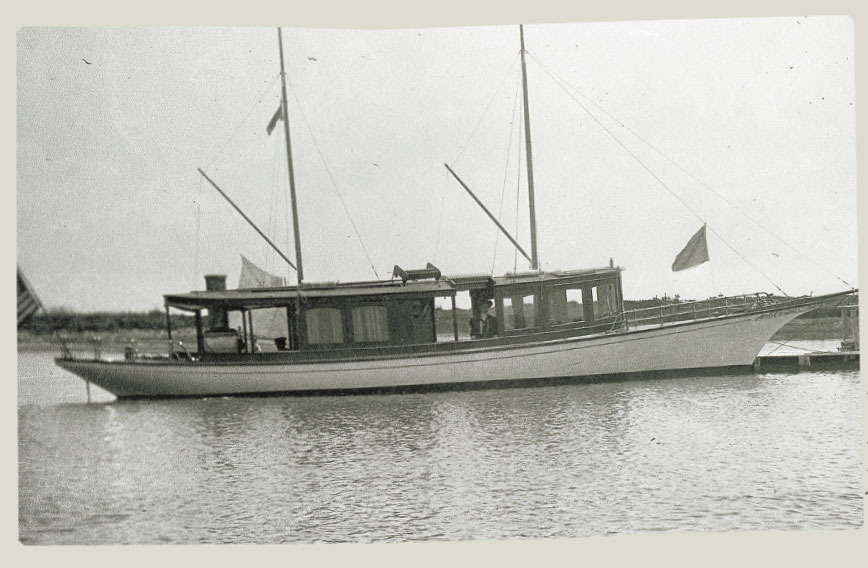
History Lesson
This boat’s story begins in 1897, when Alexander Mackay-Smith of Philadelphia commissioned the construction of a 40-foot Naphtha Launch from Gas Engine and Power Company and Charles L. Seabury and Company of New York City. He named the elegant launch Virginia to honor his wife and kept it at a family vacation home on Seal Harbor off Mount Desert Island in Maine.
The single-screw craft was powered by a 12 hp, 1,000-pound naphtha engine, a type of external combustion engine developed just before the turn of the century exclusively for powering small boats and yachts after the US Coast Guard required steam-engine operators to be licensed engineers. In 1920, the launch was acquired for Spencer Bay Camps, a fishing resort on Moosehead Lake in Maine, where it stayed until 2012. It was subsequently donated to the Antique Boat Museum in Clayton, New York, which deaccessioned the launch for auction in 2018.
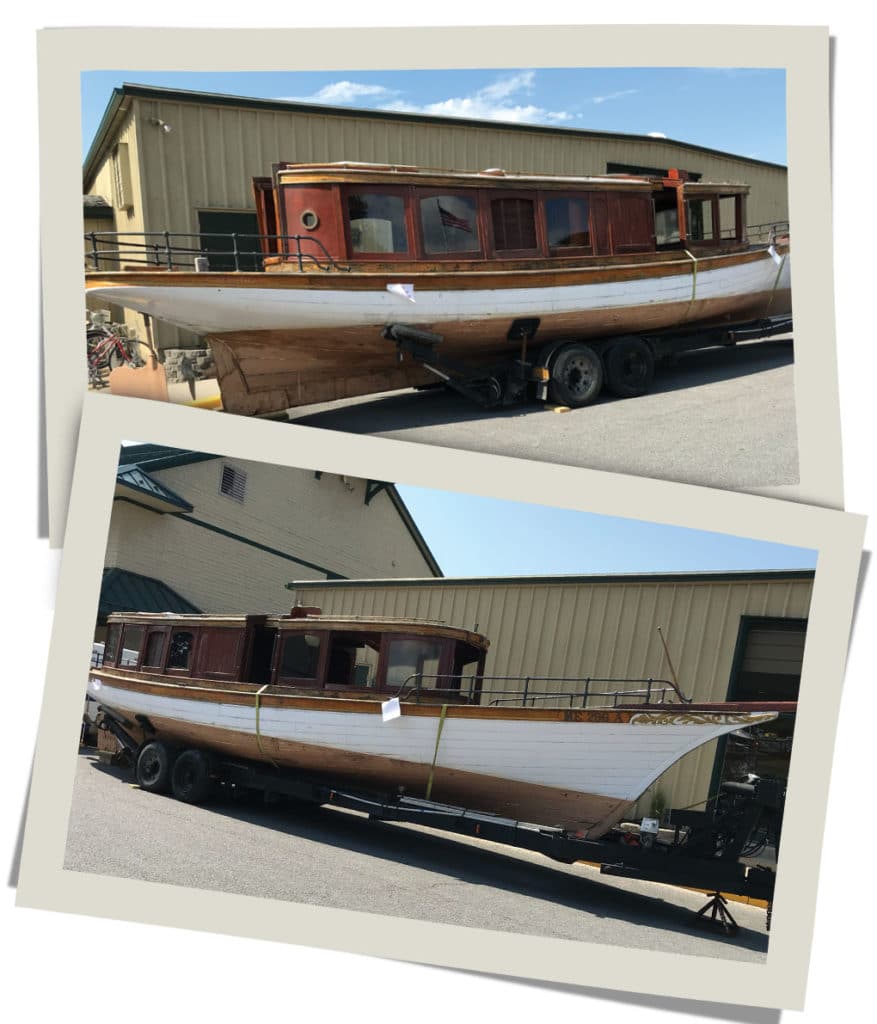
While the cabin and its handcarved details were in good condition, the boat had been allowed to badly deteriorate below the waterline. On the day of the auction, Dave Bortner, owner of Freedom Boat Service of Lake Minnetonka in Minnesota, sent a picture of the forlorn craft to a client in Wisconsin, who took a leap of faith and purchased the boat for $16,500. Thus, a two-year restoration of the launch began. Bortner says the project consumed 8,000 hours in his shop at a cost well into seven figures.
“The portions of the boat that remain original are the keel, the cabin window frames, and the interior woodwork, bulkheads and doors,” says Bortner, who founded Freedom Boat Service in 2009, and has serviced hundreds of antique and vintage boats. “The hull is all new, and frames were replaced as needed. The cabin was remodeled, in part to accommodate the new power system.”
It was a labor of love for an owner with an unlimited budget and a passion for antique craft. The finished launch incorporates many modern amenities, including an autopilot, audio system, air conditioning, bow thrusters, genset, and water and waste systems, all hidden from view.
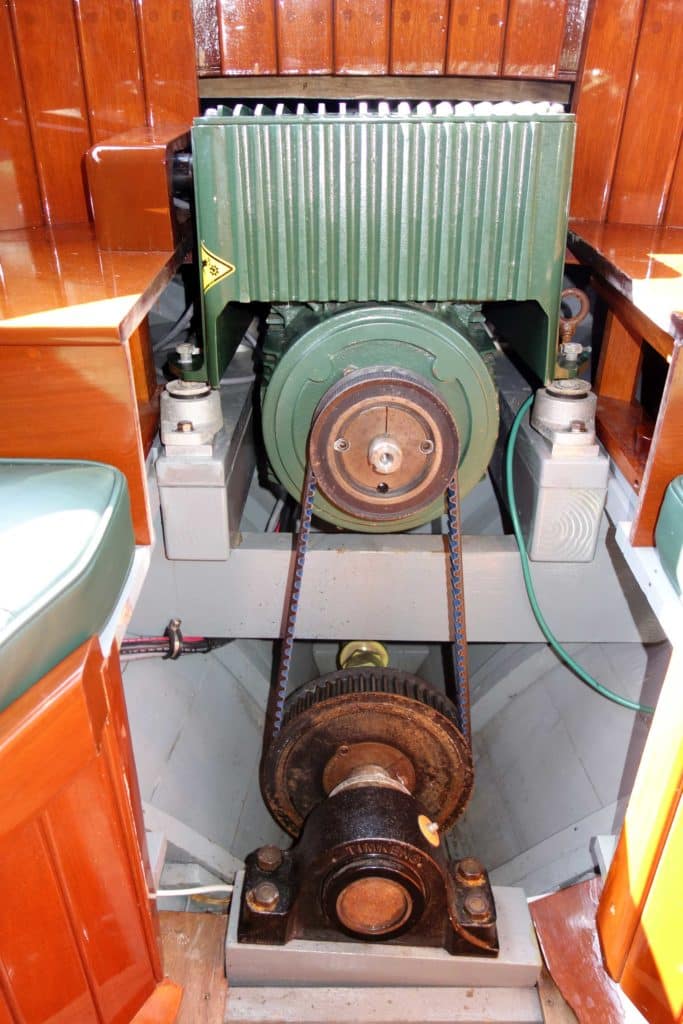
Electrification
When the boat arrived at Freedom Boat Service, it was powered by a 16 hp two-cylinder Sabb diesel engine likely installed in the 1960s. Positioned in the aft cockpit, the engine featured a direct drive to a horizontal prop shaft. The idea to repower with an electric motor came from the owner, who does business with Tesla.
“He wondered if we couldn’t power the boat using a Tesla Powerwall battery and a Tesla automobile motor,” Bortner says. “This proved to be unworkable. The Powerwall is intended for very gradual discharge, and the Tesla motor is designed to operate at very high rpm.”
Impressed with the Elco electric systems in boats that had passed through the shop for service, the Freedom team next turned to the marine electric specialist based out of Lake George, New York.
“Elco was instrumental in designing this system and delivered it ready to install,” Bortner says. “Just as with internal combustion power, I’d advise to always install as much electric power and battery capacity as you can afford and the boat will accommodate. You’ll never wish you had less of either.”
The Elco EP-40 motor selected for the launch has a continuous output rating of 17 kW, comparable to a 40 hp internal combustion engine, according to Elco. The motor alone weighs 400 pounds, has a footprint of about 19 inches square, and is 29 inches tall. The entire system, excluding instrument panel and batteries, is contained in a finned water-resistant cast-aluminum housing. Elco inboard motors are a brushless three-phase AC induction type boasting 85 to 92 percent efficiency, which Elco claims is 30 percent more efficient than a DC motor, and 40 to 50 percent more efficient than a combustion engine. The motor is rated for 50,000 hours of service, and its main shaft is the only moving part. There is nothing to maintain.
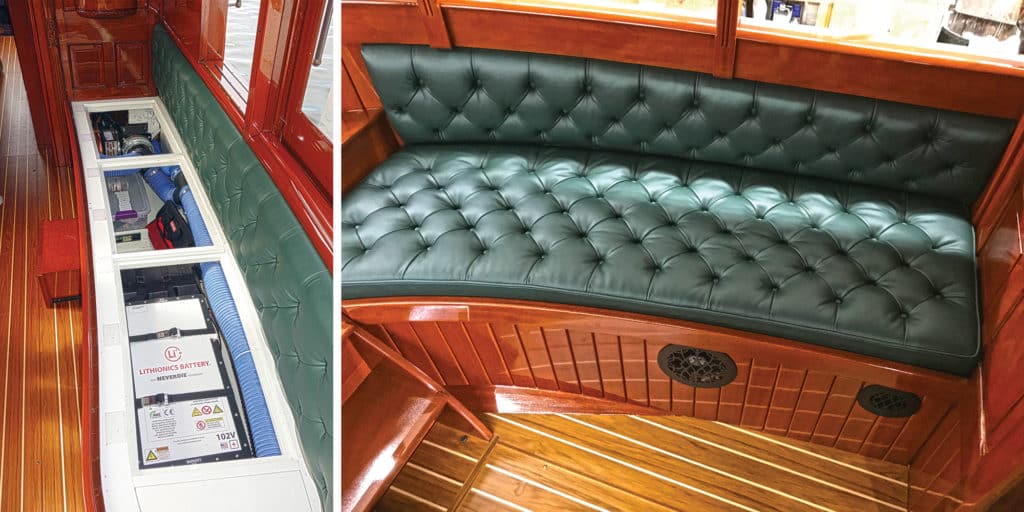
Elco motors are typically installed in direct-drive configurations. There’s no need for a transmission because the motor simply reverses when it’s time to back up. The Freedom team sought to open up space in the aft cockpit by mounting the motor above the prop shaft, with a belt drive mating the motor to the shaft. This required building a structure for motor mounts and a cabinet to cover the motor. Gates Corporation supplied the toothed belt and upper and lower pulleys, and its input was critical in determining belt alignment and tension, according to Bortner.
There was a great desire to design the power system for peak efficiency. Elco’s chief engineer, Joe Fleming, helped by calculating the hull speed—or displacement speed—of this antique running surface, which he determined to be 12 knots. An ideal displacement cruising speed, according to Fleming, is usually the square root of 0.85 of the waterline length. In this case, that was about 5.8 knots. The Elco motor has a maximum speed of 1,800 rpm. With this in mind, Fleming applied more math. The belt pulleys were sized for a 1.75:1 reduction, and the team commissioned Prop MD of Plymouth, Minnesota, to build a 19-inch-diameter-by-16-inch-pitch, three-blade bronze propeller for the boat.
The Elco EP-40 can handle up to 108 volts and is typically rigged with nine 160-pound D8 (245 Ah) 12-volt lead-acid batteries with a combined capacity of 27.9 kWh, only half of which (14 kWh) is available without shortening battery life. Freedom specified an alternative, four 102-volt Lithionics GT Series lithium-iron-phosphate batteries in series. The Lithionics batteries also weigh about 160 pounds each and are about the same size as a D8, so this choice reduced battery weight by 800 pounds and saved space. The four batteries combined store 30.8 kWh, and unlike lead-acid batteries, all of that capacity is available.
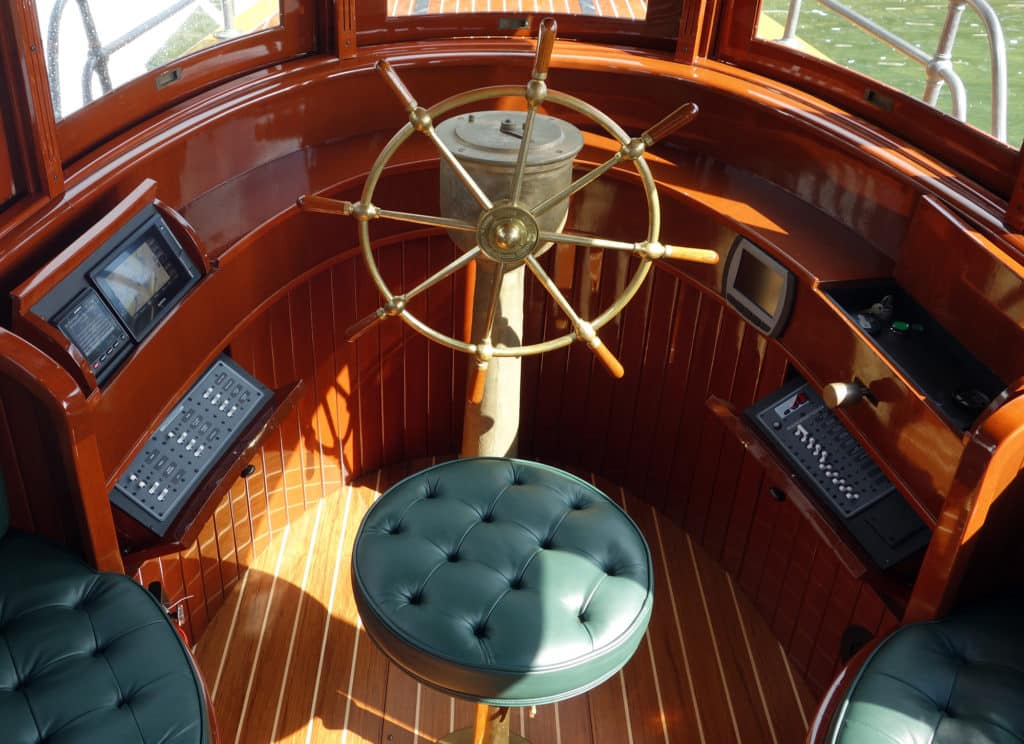
A single external Lithionics NeverDie battery management system (BMS) monitors all four batteries, can be rigged with its own state of charge (SOC) display, and is also available with Bluetooth to monitor battery voltage, state of charge, temperature, current and status code on a mobile device. Elco engineered and supplied the entire system, including cables, a throttle control, chargers and a system monitoring screen as a plug-and-play package. The cost was about $57,200. The EP-40 motor alone cost $13,995. The Lithionics batteries were $7,958 each, and the Lithionics BMS was $2,400.
The team installed two batteries each within the port and starboard settees in the forward salon. Most of the other mechanicals are below the foredeck in a space that previously held a 200-gallon copper tank for liquid naphtha. They installed a 20-by-32-inch hatch in the deck to access the bow thruster, the 5.5 kW Next Gen generator and its 12-gallon diesel tank, the BMS, two Lithionics battery chargers, and a separate Guest charger for the three 12-volt lead-acid batteries for the house system, the thruster and to crank the genset. The air-conditioning and heating unit is located below the port settee and powered by the genny.
The Lithionics 120/220-volt chargers ($840 each) are set up for two 30-amp, 120-volt shore-power circuits (until 220 is available dockside). One charges two lithium batteries and the house charger, while the other charges the other two lithium batteries.
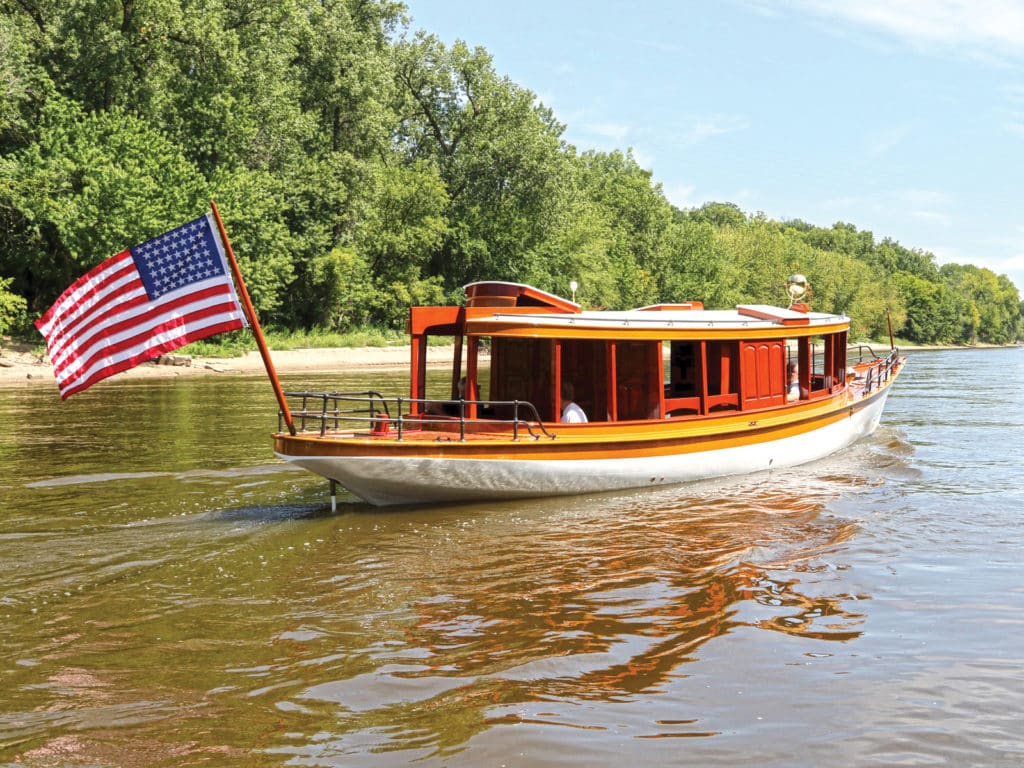
The Sea Trial
Bortner and his team had no idea how the boat would perform, and there was an immediate problem: The boat had lost so much weight that the prop was only half-submerged.
“We run into this sometimes with a wood boat that has been extensively refitted,” Bortner explains. “But this was pretty dramatic. The boat loses weight because modern wood has much less density than the old-growth wood used originally. The old bilge was likely soaked with engine oil, and the boat now carries less total powertrain weight and no fuel. We had to add 800 pounds of lead ballast along the keel to settle the boat deeper in the water.”
Read Next: Four Electric Boat Motors Compared
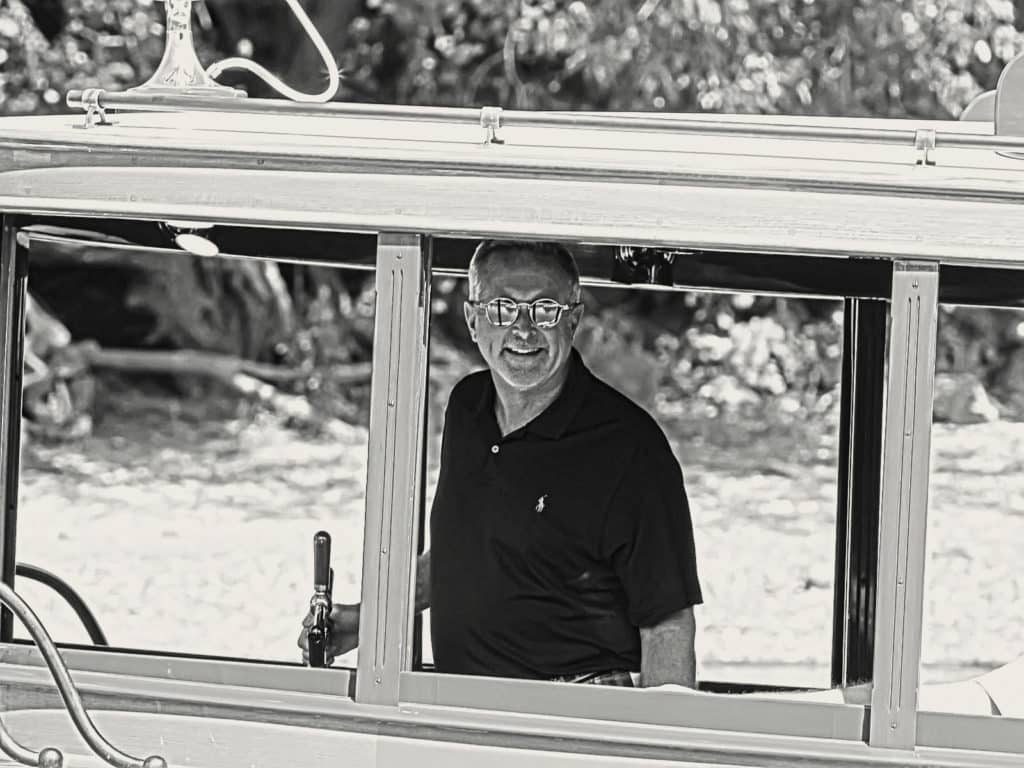
On Point, as the boat has been rechristened, lives on a custom Golden boat lift on Green Lake in Wisconsin. On a crisp autumn day, we helped Bortner remove the canvas cover, lower the lift and glide out onto the lake. The hull form is similar to a vintage sailboat, with a round bottom rocking up at the stern, so the boat is a bit tender in a crosswind. It was responsive to the rudder, however, and offered a relaxing ride. Top speed on our demo was 8.5 mph at 1,300 rpm, and at this speed the Elco screen predicted seven hours of battery reserve. We throttled back to just 650 rpm to cruise at 5 mph, which increased the battery reserve to 11 hours. But in both cases, range is about 55 to 60 miles. There was some driveline vibration at full speed, but at cruise the powertrain was silent—so much so, in fact, that the thrusters seemed startlingly loud when we docked.
While this project was clearly over the top, it still serves as an example of an ideal conversion to electric power. Silent cruising enhances boating; no maintenance enhances ownership. The cost of the repower could be reduced with half the battery capacity, and five or six hours of cruising time seems adequate. A diesel repower would cost a fraction of the cost, but the end result wouldn’t be so elegant.
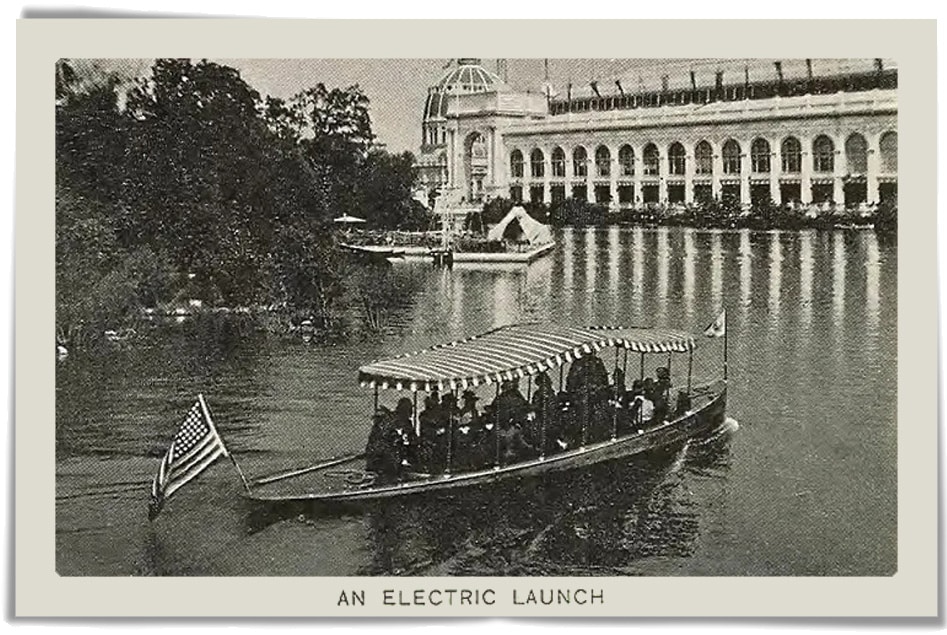
The Electric Launch Company
The Electric Launch Company (Elco) began in 1893 as a sister company to Electric Boat, with a contract to build 55 electric-powered 36-foot launches for the Chicago World’s Colombian Exposition. In 1902, Elco opened a boatyard in Bayonne, New Jersey; a decade later, it launched the first diesel-powered yacht in America. In the 1940s, Elco trailed only Chris-Craft in sales of recreational powerboats. During World War II, Elco built PT boats for the Navy, including the PT 109 commanded by John F. Kennedy. Elco closed in 1949 when Electric Boat (later General Dynamics) changed its business focus to military contracts. In 1987, Joe Fleming acquired the Elco naming rights with the intention of building replicas of the original Elco launches. In 2009, the Lamando family acquired the company, and its focus turned to building modern electric-power systems—inboards from 6 to 100 hp, and electric outboards from 5 to 50 hp. The company also offers custom-built replicas of its many classic launches.

